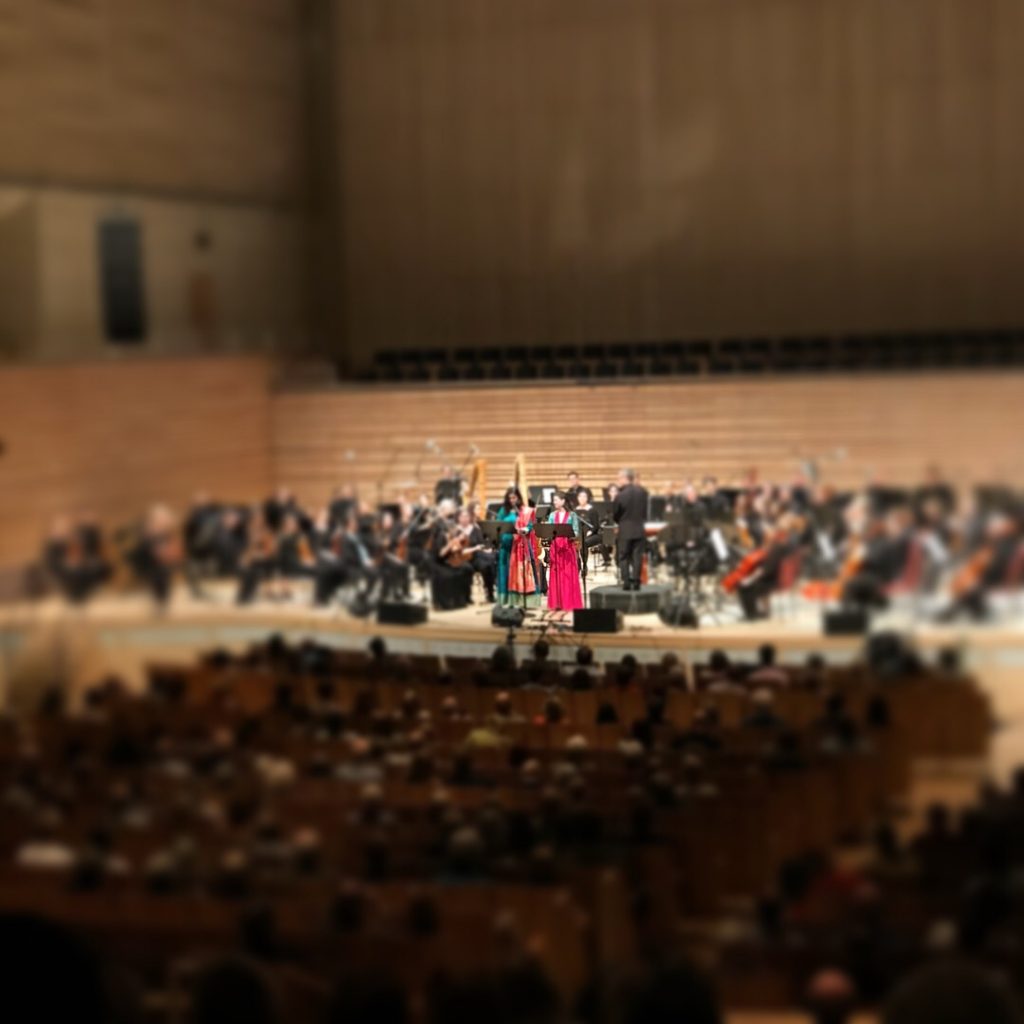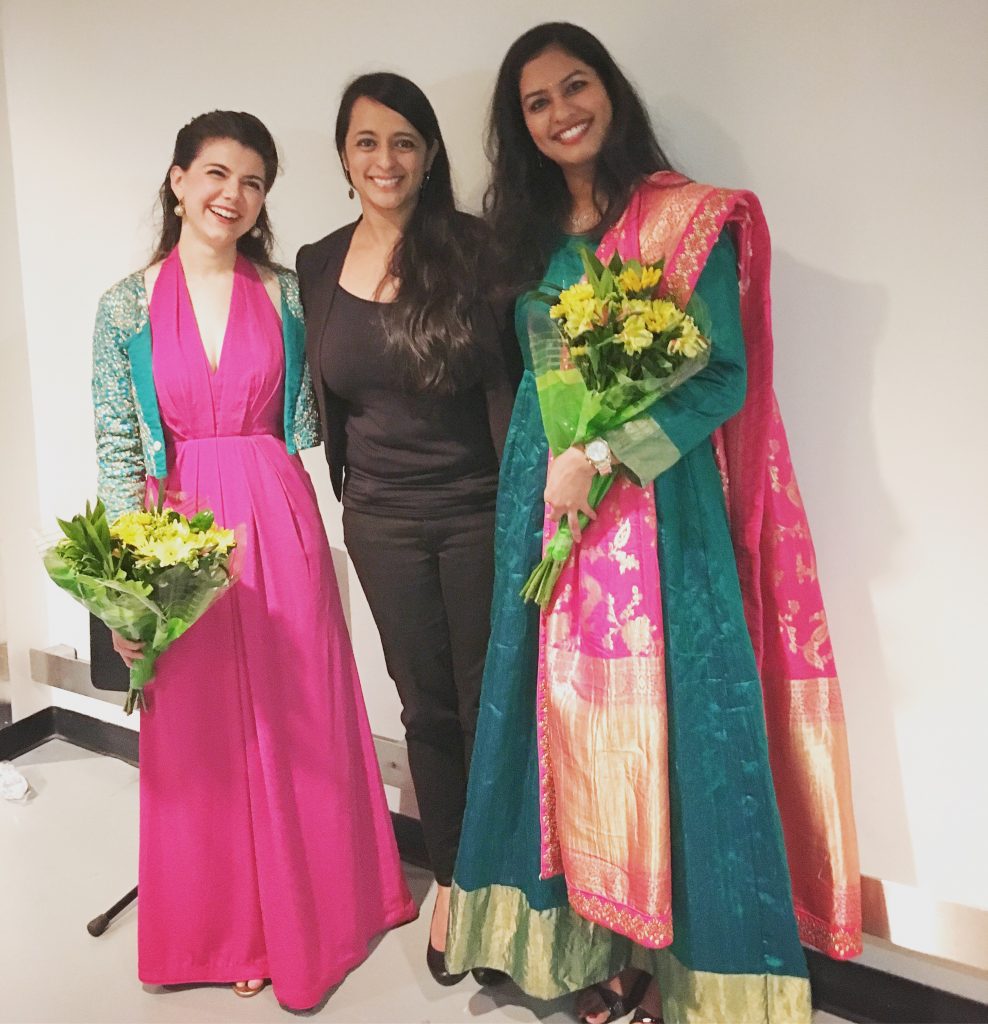

Program Notes
Meri Sakhi Ki Avaaz, at its core, is a piece about sisterhood. Each movement’s short text epitomizes the one of the many facets of having and being a sister. It is also about what sisterhood looks like when expanded beyond a single family or a single culture— when two women, from two different musical cultures create space for one another’s voices to be heard.
The first movement is a modern take on Delibes’s famous Flower Duet from the opera Lakme. In the opera, Delibes depicts two Indian women singing by a river. In 1880s France, this orientalism was a point of entry into another culture far away. But today, that culture is easily accessible, and this is my attempt to show you what an ‘updated’ version of this duet might sound like with a Hindustani singer actually present to represent herself. So much of Western art music is about creating dialogue between the old and new, responding to our vast canon and musical tradition. And for the work I do, I couldn’t think of a better jumping-off point than this classic duet.
For the second movement, I wrote a classical Hindustani bandish or ‘fixed composition’ in what they call ati-vilambit— a tempo that is so slow that the western metronome doesn’t even have a setting for it. While Hindustani musicians would normally stay in one key for an entire piece (and, to be honest, for their entire professional career), this movement modulates once every avartan, or rhythmic cycle, and also allows space for improvisation within a very rigid western orchestral structure. Additionally, the singers are singing in two different raags — the Hindustani singer is in Charukeshi, while the soprano is in Vachaspati – and as the movement goes on, the switches between the raags get closer and closer.
The third movement is about mirrors and opposites. I used two different raags that are actual mirror images of one another: Bhup, a light and sweet raag, and Malkauns, a dark, heavy raag. You will hear the shifts in tonality as the phrases cross from one into the other. Also embedded in this piece is a classic Hindustani jugalbandi (a musical competition) that is done completely in mirror image, and with both Indian and Western solfege systems, and it ends with both women crossing into one another’s musical cultures: the Hindustani singer begins singing phrases in English and the soprano joins in for ataranain harmony.
This piece has been almost a decade in the making. In 2009, I wrote a piece called Aria, for Hindustani vocalist and orchestra – it was the first time I had ever attempted to put a Hindustani musician in my work, and it was the beginning of a long journey of discovery between these two musical cultures. This piece is the result of what I’ve found along that journey — an encyclopedia of sorts, of the many points of resonance I’ve discovered between these musical cultures. One of the greatest things I’ve learned is that I cannot do it alone. These ideas are as much mine as they are Saili’s. We have spent hours and hours over many summers sitting at my kitchen table, drinking chai and dreaming up the ideas that have become this piece. And as Saili is quick to point out: this is a culmination, but also a beginning of everything that is yet to come. I might be a biological only-child, but I have found my musical soul sister in Saili.
Recording
Due to union regulations, we cannot make the recording of Meri Sakhi Ki Avaaz publicly available. If you would like to hear the recording, please contact us. In the meantime, a wonderful recording of the chamber version of Meri Sakhi Ki Avaaz is available on the Meri Sakhi Ki Avaaz (piano quintet) page.
Orchestra Breakdown
Woodwinds: 3 Fl (+picc), 3Ob, 3Cl, 2Bsn
Brass: 4Hn, 2Tpt, 3Tbn, 1Tba
Timp +2Perc
Harp, Piano*
Strings
*pianist also cues 2 short recordings (at beginning and ending of mmt 1)
Special Performance Requirements
This piece will require a Hindustani singer (amplified). Hindustani singers who do not have previous experience with a Western orchestra should take note that, though the material is all within the Hindustani tradition and does not require reading western notation, the alignment with the orchestra will feel new and often challenging.
This work, unlike my earlier work, Aria, has two soloists so that they can help and support one another in this context. The soprano and Hindustani singer should get comfortable with one another, and rehearse with a pianist (piano/vocal score available with orchestra rental) until they feel comfortable in that setting, before attempting to sing with an orchestra.
It is recommended that the singer meet with the conductor and soprano before the first rehearsal and become comfortable following visual cues (either while singing along to a recording of the piece, or a version with a rehearsal pianist) — especially practicing entering at places other than the beginning of the piece.
Singers who are dual-trained, or who have experience performing with Western ensembles should be well-equipped to handle this piece. Even if the singer has never worked as a Hindustani musician in western ensemble — for example, even if a singer has basic Western choral experience — this should be sufficient to understand the Western orchestral working process.
In instances where a Hindustani singer may need assistance with cues, the soprano can also serve as an intermediary on the stage (for rehearsals and also for performance), cross cueing at entrances and wherever else is necessary.
Text
(English translations included in parentheses where Hindi is different from paired phrase)
I.
Two flowers, one branch
Ek daali, do kaliyaan
In this garden of life
Is zindagi ke bagh mein
Bahine bane saheliyaan (sisters become soulmates)
My sister, my soul
Meri sakhi, saheliyaan
II.
Meri sakhi ki avaaz (my sister’s voice)
Sweet is the voice of my sister
ranj mein
in the season of sorrow
umeed ka ehsaas ([gives] a feeling of hope)
III.
Saaya nahi, pratibimb hai bahin
Not a shadow but a reflection of my sister
Vibhil chabi, ek dusre ka darpan
Lucid image, a mirror of one another
My sister is both my mirror and my opposite
Vo aks hai aur saaya bhi
Audio Guide
Here is how to do the clapping in movement 3 (for violin 2 and viola)
Premiere/Performances
This piece was commissioned by Albany Symphony. It was premiered on June 2, 2018 in Albany, NY with Saili Oak performing vocals.
Press/Reviews
“Reena Esmail conceived a beautiful amalgamation in “My Sister’s Voice” with the Hindustani singer Saili Oak and the always impressive soprano Fitz Gibbon. The work’s marvelous lyricism, its superb string writing and equally perfect balances allowed Oak’s…earthy voice and Fitz Gibbon’s lush tones to blend and soar. The audience jumped to its feet, cheering and applauding loudly.” – Daily Gazette
